Smoothies are a fantastic way to ensure your children get the essential nutrients they need, all while enjoying a delicious treat. Packed with vitamins, minerals, and natural flavors, smoothies can be a fun and creative way to sneak fruits and even vegetables into your child’s diet. Whether it’s a quick breakfast, a midday snack, or a refreshing drink after playtime, smoothies offer endless possibilities for combining healthy ingredients into a blend kids will love.
In this blog post, we’ll explore the best smoothies for children, highlighting recipes that are not only packed with vitamins but also bursting with flavor. From berry-rich delights to tropical fruit favorites, these smoothies are designed to please even the pickiest eaters. Plus, we’ll share tips for making smoothies fun, nutritious, and irresistible for your little ones!
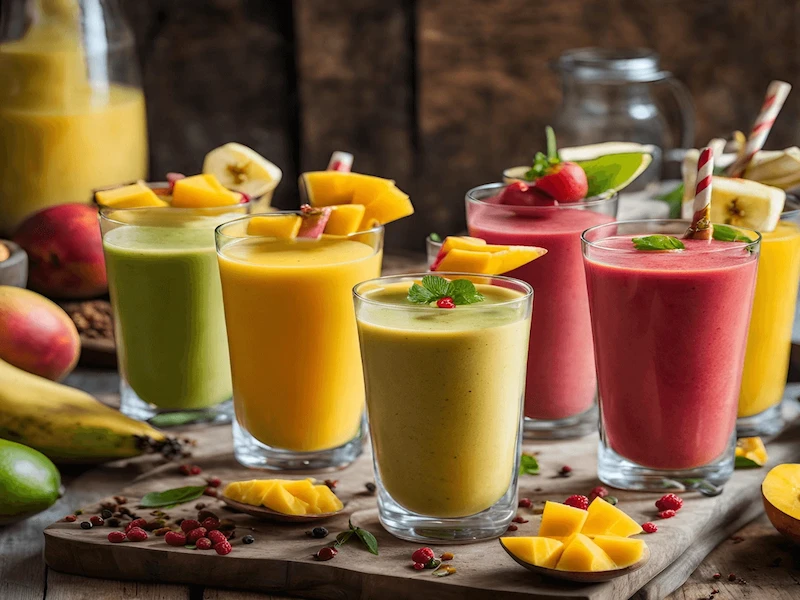
Why Smoothies Are Perfect for Children
Smoothies are an excellent way to provide essential nutrients while being fun and delicious for kids. According to Healthy Eating Research, incorporating fruits and vegetables into kids’ diets can improve their overall health and well-being. Smoothies make this process easy by blending nutritious ingredients into one irresistible drink.
Smoothies are more than just tasty beverages—they are a versatile and nutritious option that meets the needs of growing children while catering to busy parents. Here’s why smoothies should be a staple in your child’s diet:
1. Packed with Essential Vitamins and Nutrients
Smoothies are an excellent way to provide children with the vitamins and nutrients their growing bodies require. By combining a variety of fruits, vegetables, and nutrient-rich add-ins, you can ensure they get a healthy dose of:
- Vitamin C: Found in oranges, strawberries, and mangoes, it helps boost immunity and keep colds at bay.
- Calcium: Dairy-based smoothies or plant-based milk options like almond or soy milk offer calcium for strong bones and teeth.
- Antioxidants: Blueberries, spinach, and chia seeds are antioxidant powerhouses that support overall health.
- Fiber: Bananas, apples, and leafy greens aid digestion and promote a healthy gut.
Smoothies make it easier to pack all these nutrients into one quick and convenient drink, perfect for starting the day or refueling after school.
2. A Delicious Way to Include Fruits and Vegetables
Getting children to eat their daily servings of fruits and vegetables can be a challenge. Smoothies provide a simple solution by masking the taste of vegetables with naturally sweet fruits. For example:
- Blend spinach or kale with bananas and strawberries for a “hidden greens” smoothie.
- Add carrots to a tropical smoothie with pineapple and mango for a bright, sweet flavor.
The vibrant colors and sweet taste make smoothies irresistible, even to picky eaters who might otherwise refuse veggies.
3. Perfect for Busy Parents and Picky Eaters
Smoothies are quick to make, requiring minimal prep time, making them ideal for busy mornings or on-the-go snacks. Blend, pour, and serve!
- Customizable Recipes: Parents can tailor smoothies to their child’s preferences, adjusting the ingredients to suit taste and dietary needs.
- Appeals to Picky Eaters: Smoothies allow parents to sneak in healthy ingredients without their kids noticing. Add a handful of oats, a dollop of yogurt, or even a pinch of flaxseed for extra nutrition without altering the taste.
4. A Fun and Engaging Food Option
Kids love smoothies because they’re colorful, delicious, and fun to drink. You can make the experience even more enjoyable by:
- Letting kids choose their favorite fruits or toppings.
- Serving smoothies in fun cups with colorful straws or lids.
- Add playful garnishes, like a slice of fruit on the rim or sprinkles on top.
This makes smoothies not just a healthy choice but also a bonding opportunity for parents and children.
Incorporating smoothies into your child’s diet can help them develop healthier eating habits while keeping mealtime stress-free and enjoyable. With so many creative possibilities, smoothies truly are a win-win for the whole family!
Top Ingredients to Include in Children’s Smoothies
The beauty of smoothies lies in their versatility and ability to accommodate a wide range of healthy ingredients. From sweet fruits to nutrient-packed vegetables and flavorful add-ins, the options are endless. Here’s a breakdown of the best ingredients to include in kids’ smoothies to make them nutritious, delicious, and appealing to young taste buds:
1. Fruits Packed with Flavor and Nutrients
Fruits are the foundation of any good smoothie, providing natural sweetness, vibrant colors, and essential vitamins. Some of the best options include:
- Bananas: Creamy texture and natural sweetness; a great source of potassium and energy.
- Berries: Strawberries, blueberries, and raspberries are rich in antioxidants and Vitamin C, which boost immunity and protect against illnesses.
- Mangoes and Pineapples: These tropical fruits add a refreshing flavor and are loaded with Vitamin A and digestive enzymes.
- Apples and Pears: Provide fiber and a subtle sweetness that pairs well with other ingredients.
2. Hidden Vegetables for Extra Nutrition
Smoothies are the perfect way to sneak vegetables into your child’s diet without them even noticing. Mild-flavored vegetables blend seamlessly with sweet fruits and add a boost of essential nutrients. Try these options:
- Spinach: A nutrient powerhouse packed with iron, folate, and Vitamin K. Its mild flavor is undetectable when blended with fruits like bananas or berries.
- Carrots: Add a subtle sweetness and a vibrant orange color, along with Vitamin A for healthy eyesight.
- Zucchini: A surprising addition that adds creaminess without altering the taste.
- Beets: Their natural sweetness and bright pink color make them a fun and nutritious choice.
Pro Tip: Steam vegetables like carrots or beets before blending for a smoother texture and easier digestion.
3. Healthy Add-Ins for Extra Benefits
Elevate the nutritional profile of your smoothies with these nutrient-dense add-ins:
- Greek Yogurt: Adds protein, calcium, and probiotics for a creamy and tangy flavor. Great for supporting gut health and strong bones.
- Nut Butters: Almond butter or peanut butter provides healthy fats, protein, and a rich flavor kids will love.
- Chia Seeds or Flaxseeds: Packed with omega-3 fatty acids and fiber to support brain development and digestion.
- Avocado: Adds healthy fats and creaminess while being virtually tasteless in the blend.
- Oats: A great way to add fiber and make the smoothie more filling, perfect for breakfast.
4. Liquid Bases for the Perfect Consistency
The liquid you choose can affect the flavor, consistency, and nutritional content of the smoothie. Popular options include:
- Milk: Whole milk or plant-based options like almond milk, oat milk, or coconut milk add creaminess and calcium.
- Juice: Orange juice or apple juice provides sweetness and Vitamin C but should be consumed in moderation to avoid excess sugar.
- Water or Coconut Water: A lighter option for hydration without added calories.
Experiment with different liquid bases to find what your child enjoys most.
5. Natural Sweeteners (Optional)
If your smoothie needs a little extra sweetness, opt for natural sweeteners instead of refined sugar:
- Honey: Adds a mild sweetness and natural antibacterial properties (for kids over 1 year old).
- Maple Syrup: A vegan-friendly alternative with a unique flavor.
- Dates: Blend these for a rich, caramel-like sweetness and a boost of fiber.
6. Toppings for a Fun Twist
Kids love toppings, and they can make smoothies even more exciting:
- Sliced fruits like bananas or strawberries.
- A sprinkle of granola for crunch.
- A dollop of whipped cream for a special treat.
- Mini chocolate chips or colorful sprinkles for extra fun.
By combining these ingredients, you can create smoothies that are both nutritious and irresistible to children. The key is to balance flavors, experiment with combinations, and cater to your child’s preferences while ensuring they’re getting the nutrients they need.
Easy and Fun Smoothies for Children
Making smoothies at home is not only quick and simple but also a fun activity for the whole family. Below are some easy-to-follow recipes that are packed with nutrition and bursting with flavors your kids will love. These smoothies are designed to cater to children’s taste buds while incorporating healthy ingredients that promote growth and energy.
1. Berry Blast Smoothie
A classic favorite loaded with antioxidants and natural sweetness.
Ingredients:
- 1 cup of fresh or frozen strawberries
- ½ cup of blueberries
- 1 ripe banana
- 1 cup of Greek yogurt or milk (dairy or plant-based)
- 1 tablespoon of honey (optional)
Instructions:
- Add all the ingredients to a blender.
- Blend until smooth and creamy.
- Serve in a fun cup with a colorful straw, and top with a few fresh berries for decoration.
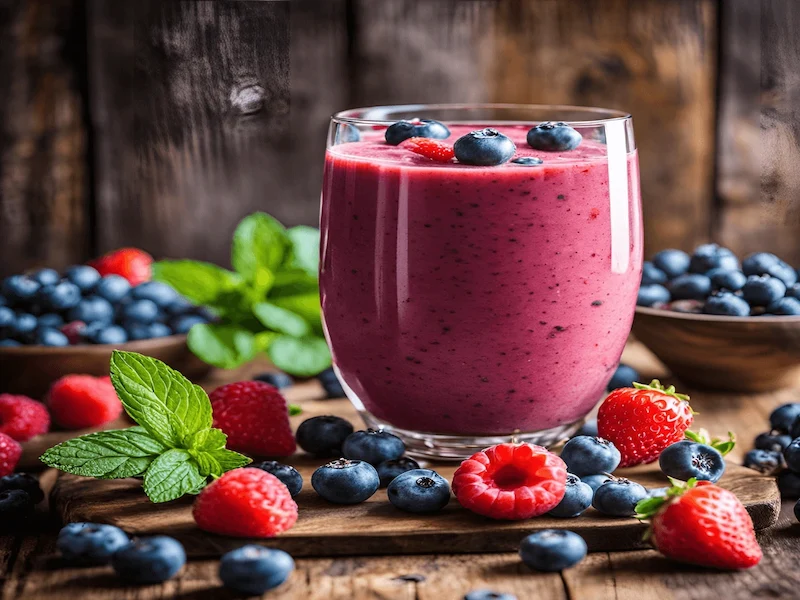
Why Children Will Love It:
The vibrant pink-purple color and fruity flavor make this smoothie a crowd-pleaser, even for picky eaters.
2. Tropical Paradise Smoothie
Bring a taste of the tropics to your child’s day with this refreshing and energy-boosting drink.
Ingredients:
- 1 cup of pineapple chunks
- 1 cup of mango pieces
- 1 banana
- 1 cup of coconut milk or orange juice
- A handful of shredded coconut (optional)
Instructions:
- Combine all the ingredients in a blender and blend until smooth.
- Pour into a glass, and garnish with a slice of pineapple or a paper umbrella for a tropical vibe.
Why Children Will Love It:
The sweet and tangy tropical flavors feel like a vacation in a cup!
3. Green Superhero Smoothie
A nutritious blend designed to make kids feel like superheroes while sneaking in leafy greens.
Ingredients:
- 1 cup of fresh spinach or kale
- 1 banana
- ½ an avocado
- 1 cup of apple juice or water
- 1 tablespoon of chia seeds (optional)
Instructions:
- Blend all ingredients until smooth. Adjust the liquid if needed for your desired consistency.
- Serve in a green-themed cup and call it “Hulk Juice” or “Superhero Fuel” for extra fun.
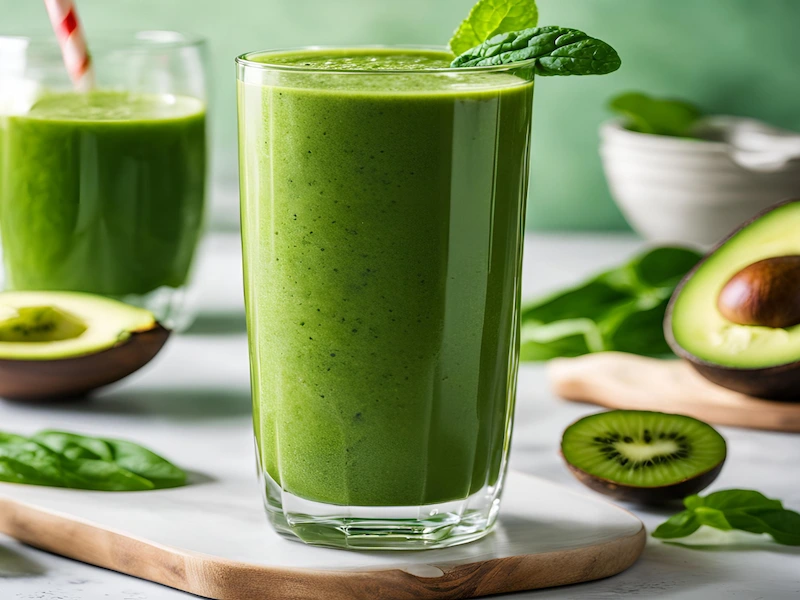
Why Children Will Love It:
The creamy texture and sweet taste of the banana completely mask the spinach, while the fun name makes it exciting to drink.
4. Immune-Boosting Citrus Smoothie
A zesty, vitamin-rich smoothie is perfect for keeping colds away.
Ingredients:
- 1 orange, peeled and segmented
- ½ cup of mango chunks
- 1 medium carrot (steamed or raw)
- 1 teaspoon of grated ginger
- 1 cup of orange juice or water
Why Children Will Love It:
The sweet citrus flavor is refreshing, and the bright orange color is visually appealing.
5. Chocolate Banana Delight Smoothie
For children with a sweet tooth, this smoothie is a healthier alternative to dessert.
Ingredients:
- 1 ripe banana
- 1 cup of milk (dairy or plant-based)
- 1 tablespoon of cocoa powder
- 1 tablespoon of almond butter or peanut butter
- Add a drizzle of honey or a few pitted dates for sweetness
Instructions:
- Blend all the ingredients until they are creamy and smooth.
- Serve in a cup with a sprinkle of cocoa powder or a dollop of whipped cream for a treat.
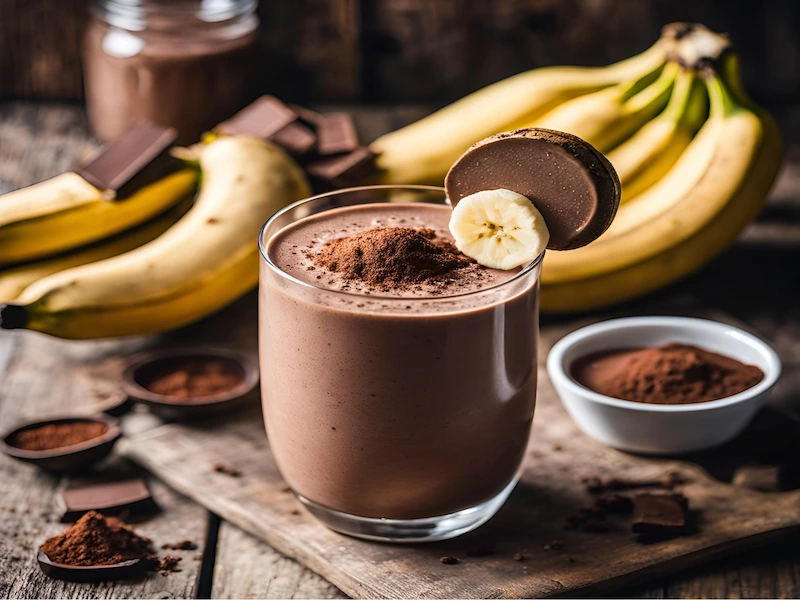
Why Children Will Love It:
It tastes like a chocolate milkshake but is packed with nutrients like potassium and healthy fats.
Tips for Making These Smoothies Even More Fun:
- Let Children Customize: Set up a “smoothie bar” with pre-cut fruits and toppings so kids can choose their favorites.
- Add Fun Names: Give each smoothie a playful name like “Berrylicious,” “Mango Magic,” or “Jungle Juice.”
- Serve Creatively: Use mason jars, colorful cups, or silly straws to make the smoothies more exciting to drink.
These recipes are not only delicious but also a great way to ensure your children get the vitamins, minerals, and energy they need for their growing bodies. Plus, they’ll love being involved in the blending process!
Tips for Making Smoothies that Children Will Love
While smoothies are naturally delicious and nutritious, making them truly irresistible to children requires a little creativity and a few key strategies. Here are some expert tips for crafting smoothies that children will not only enjoy but also look forward to drinking:
1. Choose Naturally Sweet Ingredients
The key to making smoothies that kids love lies in selecting naturally sweet ingredients that don’t require added sugar. Fruits like bananas, mangoes, and berries provide the right amount of sweetness, which helps eliminate the need for refined sugars. Here’s how you can keep your smoothies naturally sweet:
- Bananas: Use ripe bananas for extra sweetness and creamy texture.
- Mangoes and Pineapples: These tropical fruits are loaded with natural sugars and vitamins, making them a kid favorite.
- Apple and Pears: Offer mild sweetness and a refreshing flavor that children often enjoy.
- Dates or Honey: For an extra touch of sweetness, consider adding a small amount of dates (a natural sugar) or honey for kids over one year old.
By relying on these ingredients, you can create smoothies that are deliciously sweet without the need for any processed sugar.
2. Experiment with Fun Flavors and Colors
children are more likely to enjoy smoothies that are visually appealing and packed with vibrant colors. The brighter and more colorful the smoothie, the more likely it will catch their attention. Try these tips:
- Mix and Match Fruits and Vegetables: Play with different combinations to create exciting colors. For example, blending strawberries with blueberries gives you a lovely pinkish-purple hue, while combining spinach with mango creates a fun green smoothie.
- Use Spirulina or Matcha: For green smoothie lovers, consider adding spirulina powder (rich in nutrients) or matcha for a punch of color and an earthy flavor.
- Layer Smoothies: Create beautiful layers of different flavors and colors for added visual appeal. You can use berries in one layer, a green spinach blend in another, and a creamy banana base in the third.
- Add Toppings: Let kids top their smoothies with fun additions like granola, chocolate chips, sliced fruit, or a sprinkle of coconut flakes to make the experience interactive and more exciting.
By mixing vibrant ingredients and adding creative toppings, you can make smoothies that not only taste good but also look fun and appealing to children.
3. Use Kid-Friendly Presentation
Sometimes, it’s all about the presentation. A smoothie served in a fun and exciting way can make a huge difference. Here’s how to make smoothies even more fun for kids:
- Fun Cups and Straws: Choose colorful cups or jars and pair them with fun, reusable straws. There are also cups with characters, animals, or cartoon designs that make drinking smoothies even more fun.
- Smoothie Bowls: Instead of a traditional smoothie, try making a smoothie bowl. Pour the smoothie into a bowl, and let your child top it with their favorite fruits, nuts, and seeds. Eating with a spoon can make the experience feel special and give them more control over the toppings.
- Create Fun Themes: Tie your smoothies to themes, such as “Superhero Smoothie” for a nutrient-packed green smoothie or “Pirate Punch” for a tropical fruit blend. You can even use small figurines or themed cups to match the smoothie.
These little touches can make smoothie time feel like a treat rather than just another meal.
4. Get Children Involved in the Process
Children are more likely to enjoy a smoothie if they have a hand in making it. Getting them involved in the preparation process not only makes it more fun but also helps them feel invested in what they’re eating. Here’s how to include kids in the smoothie-making process:
- Let Them Choose Ingredients: Ask your child to pick their favorite fruits or toppings for the smoothie. You can create a “smoothie bar” with a variety of fruits, nuts, seeds, and sweeteners, and let your child assemble their perfect blend.
- Help with Blending: If your child is old enough, allow them to press the button on the blender (with supervision, of course). It gives them a sense of achievement and makes the process feel interactive.
- Experiment with New Ingredients: Allow them to try new ingredients, such as chia seeds, oats, or spinach. When kids are part of the decision-making process, they are more likely to try new things and enjoy them.
5. Make Smoothies on Special Occasions
Smoothies don’t have to be just a regular part of the daily routine—they can be a fun treat to look forward to. Here’s how you can turn smoothie time into a special occasion:
- Smoothie “Happy Hour”: Set a designated time during the day, such as after school or during a family movie night, when everyone can enjoy a smoothie together.
- Smoothie Party: For birthdays or playdates, host a smoothie-making party where kids can create their unique blends, mixing their favorite fruits and toppings.
- Themed Smoothies: As mentioned earlier, make smoothies even more exciting by turning them into themed treats—like a “Frozen” themed smoothie for a winter wonderland or a “Rainbow Smoothie” for an educational treat about colors.
When smoothies become a special treat, kids will get excited about them and look forward to every smoothie session.
6. Keep it Balanced and Nutritious
While it’s fun to make smoothies appealing, it’s equally important to ensure that they are nutritious. Include a variety of fruits, vegetables, and protein sources to create a balanced smoothie that will fuel your child’s day. Avoid loading the smoothie with too many sweeteners or sugary fruit juices. Instead, opt for a blend of whole fruits and nutrient-dense ingredients that provide essential vitamins, minerals, and healthy fats.
Pro Tip: If your child is hesitant about trying a new ingredient (like spinach or flaxseeds), start with small portions and gradually increase the quantity as they get used to the taste.
Conclusion
Smoothies are more than just a fun treat; they are a powerhouse of nutrition, offering a quick, easy, and delicious way to provide your children with the essential vitamins, minerals, and nutrients they need to grow strong and healthy. Whether you’re looking to boost their immune system, support healthy bones, or simply ensure they get more fruits and vegetables, smoothies are a perfect solution.
By combining the right ingredients—fruits, vegetables, healthy fats, and protein—you can create nutrient-packed smoothies that not only taste great but also contribute to your child’s overall well-being. The beauty of smoothies lies in their versatility: you can customize them to your child’s taste preferences and dietary needs while sneaking in ingredients they might otherwise refuse to eat.
As parents, it’s important to embrace creative, enjoyable ways to help our children develop healthy eating habits, and smoothies provide an excellent opportunity to do just that. By making smoothie time fun and engaging, kids are more likely to be excited about healthy food choices and develop a positive relationship with nutrition that will benefit them throughout their lives.
So, the next time you’re looking for a healthy snack or breakfast idea, reach for the blender and whip up a smoothie that’s packed with vitamins and flavor. Experiment with different ingredients, involve your children in the preparation process, and watch them enjoy every sip!
Don’t forget to share your favorite smoothie combinations or any tips you have for making smoothies more fun and nutritious for kids in the comments below. Let’s inspire each other to keep our little ones healthy, happy, and well-nourished!
(FAQS): Frequently Asked Questions About Smoothies for Children
Smoothies are a wonderful way to ensure your child is getting the nutrition they need, but it’s natural for parents to have questions. From portion sizes to ingredient choices, here are some of the most common concerns and answers to help you make the best smoothies for your kids:
1. Are smoothies a good replacement for meals?
Smoothies can be a great addition to your child’s diet, but they should not be used as a complete meal replacement regularly. While smoothies provide essential nutrients, they might lack the variety of food groups needed for a balanced meal. However, smoothies can make excellent breakfast options or snacks when paired with other food groups like whole grains or lean proteins.
- Tip: If you’re making a smoothie to replace a meal, try to add more protein and fiber to make it more filling. Consider including ingredients like Greek yogurt, oats, or nut butter, which will keep your child fuller for longer.
2. How can I make smoothies dairy-free?
If your child is lactose intolerant or follows a dairy-free diet, there are plenty of dairy alternatives to make a smoothie that’s still rich and creamy. Here are some great options:
- Plant-Based Milks: Almond milk, coconut milk, soy milk, and oat milk are all fantastic substitutes. Each has a slightly different flavor and texture, so you can experiment to find the one your child enjoys most.
- Coconut Yogurt or Soy Yogurt: These are great alternatives to Greek yogurt if you want to keep the smoothie creamy without dairy.
- Frozen Banana or Avocado: These ingredients can add creaminess to a smoothie without the need for dairy products.
- Coconut Water: For a lighter option, coconut water hydrates and adds a subtle sweetness.
3. Can I make smoothies ahead of time?
Making smoothies in advance is a fantastic way to save time, especially for busy mornings or when you’re on the go. There are several ways to prepare smoothies ahead of time:
- Prepped Smoothie Packs: Preassemble all the ingredients (except the liquid) in a freezer-safe bag. This can include fruits, vegetables, seeds, and even yogurt. When you’re ready to blend, just add your liquid and blend away!
- Freezing Smoothies: You can freeze an already blended smoothie in a container or ice cube trays. When you’re ready to serve, simply thaw or blend again with a bit of added liquid.
- Storage Tips: If you’re making a smoothie ahead of time, store it in an airtight container in the fridge. It’s best to consume it within 24-48 hours for the best taste and nutritional value.
Keep in mind that while smoothies can last for a short period, they’re best enjoyed fresh to maintain their flavor and nutrient content.
4. How do I get my children to drink green smoothies?
Getting children to enjoy a green smoothie, particularly one with leafy vegetables like spinach or kale, can be challenging. However, there are some simple tricks to make green smoothies more appealing:
- Add Sweet Fruits: Combine greens with naturally sweet fruits like bananas, mangoes, or apples to balance out the flavor.
- Make It Colorful: Kids are attracted to vibrant colors, so add a variety of colorful fruits and vegetables to your smoothie. For instance, blending spinach with berries will give the smoothie a fun purple or green color.
- Start Small: If your child is new to green smoothies, start with a small amount of greens and gradually increase it as their taste buds adjust.
- Fun Straws or Toppings: Make the smoothie more appealing by serving it in a fun cup with a colorful straw. You can even add a fun topping, such as sprinkles or a slice of fruit, to make it feel like a special treat.
5. Can I use frozen fruits and vegetables in smoothies?
Yes! Frozen fruits and vegetables are not only convenient but also retain most of their nutrients, making them a great choice for smoothies. Here are a few benefits of using frozen produce:
- Convenience: Frozen fruits and veggies are pre-washed, pre-chopped, and ready to go, saving you time in the kitchen.
- Cost-Effective: Frozen produce can be more affordable than fresh produce, especially if certain fruits or vegetables are out of season.
- Texture: Frozen fruits can give your smoothie a thicker, creamier texture without the need for ice.
When using frozen produce, just be sure to adjust the liquid amount since frozen ingredients can make your smoothie thicker.
6. How can I make smoothies more filling for my children?
To turn a smoothie into a more substantial snack or meal, include ingredients that add protein, fiber, and healthy fats. These will help keep your child full and satisfied:
- Protein: Greek yogurt, nut butters (like almond or peanut butter), or protein powders (like pea or whey protein) add protein to keep your child full longer.
- Fiber: Ingredients like oats, chia seeds, flaxseeds, or even avocado can help increase the fiber content of your smoothie, promoting digestive health and fullness.
- Healthy Fats: Healthy fats from sources like avocado, nuts, seeds, or coconut oil will help your child stay satiated throughout the day.
7. Are smoothies high in sugar?
Smoothies made at home can be very low in sugar, depending on the ingredients you choose. The main concern with smoothies is the amount of fruit or juice used, as they can add up in sugar content. To ensure your smoothies are balanced:
- Use Whole Fruits: Whole fruits (rather than fruit juices) contain fiber, which helps slow the absorption of sugar and promotes digestive health.
- Limit Added Sweeteners: Avoid adding too much honey, syrup, or refined sugars. Instead, rely on the natural sweetness of fruits like bananas and berries.
- Balance with Vegetables: Including more vegetables like spinach, kale, or zucchini can reduce the overall sugar content of the smoothie while adding essential nutrients.

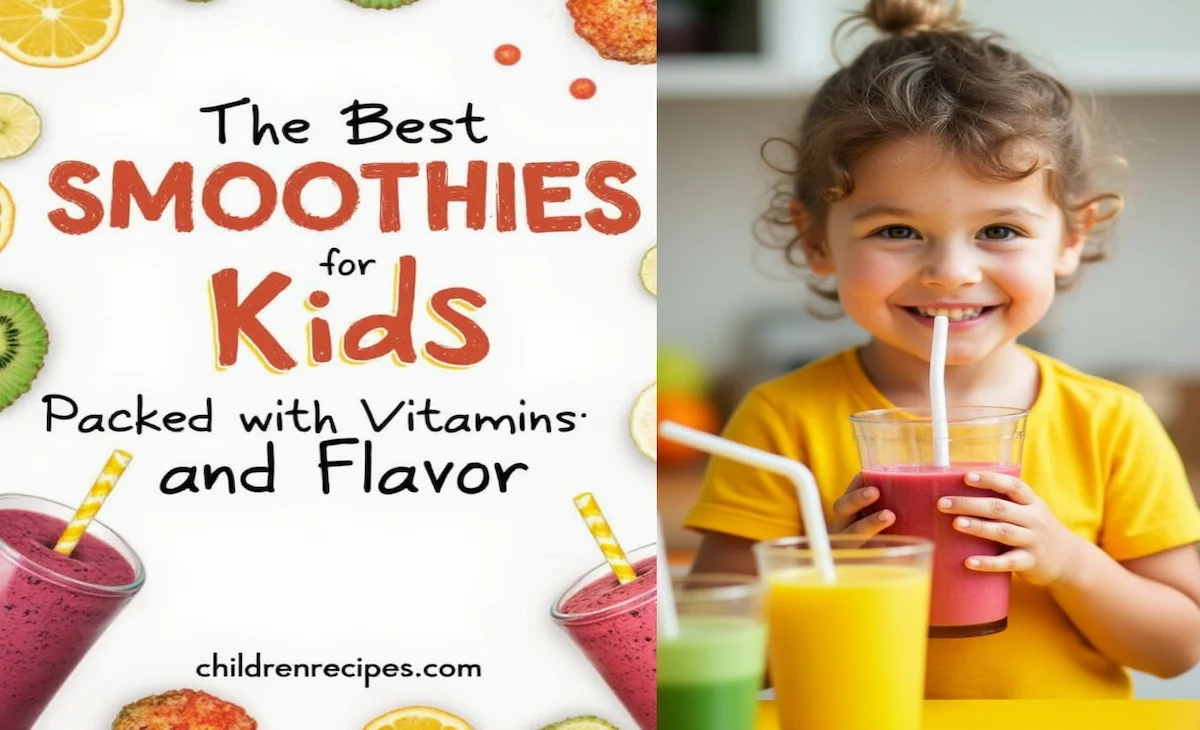
4 thoughts on “The Best Smoothies for Children: Packed with Vitamins and Flavor”